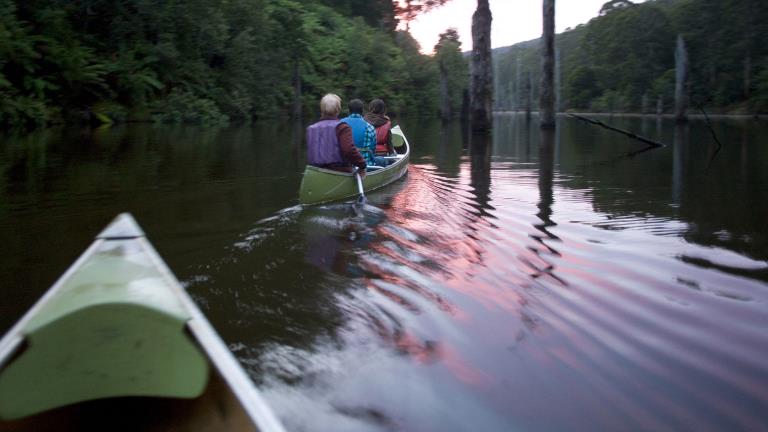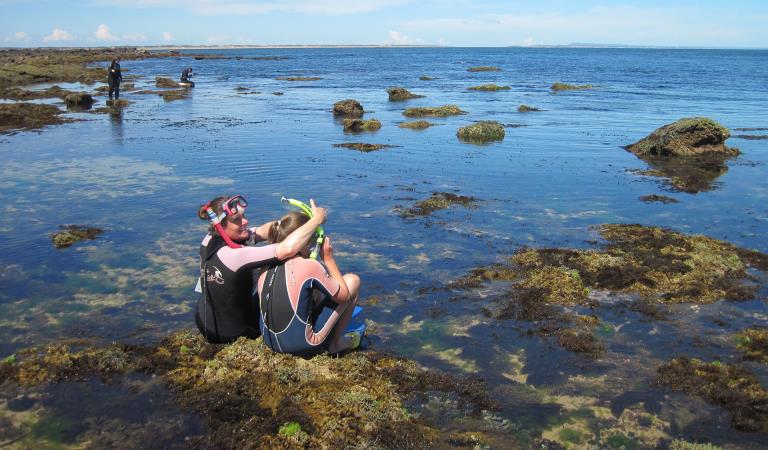Explore
Wilsons Promontory Marine National Park
Wilsons Promontory Marine National Park is a diver’s paradise. Extending off the southern coast of Wilsons Prom, Victoria’s largest marine protected area is home to a spectacular underwater world.
Granite cliffs plunge below the surface and give way to colourful sponge gardens and rich marine ecosystems.
Wilsons Promontory Marine National Park is home to one of the richest marine ecosystems off the coast of Australia – rivalling that of the Great Barrier Reef.
Dive in and spot brilliantly coloured fish such as the Red Velvetfish, Wrasse, Eastern Blue Groper, and schools of Berber. Boulders and caves harbor colourful gardens of giant sponges, fan-shaped Georgian corals, sealace colonies, sea-tulips, and sea whips. Keep an eye out for vividly coloured sea stars, Lace Corals and the rare Weedy Seadragon hiding out amongst the vegetation.
If diving isn’t your forte, on calm days bring your snorkel and plunge into the waters of Norman Beach, the southern flank of Picnic Bay and Refuge Cove. Or join a tour to explore the offshore rock stacks and islands teeming with colonies of fur seals and oceanic birds such as Little Penguins, Fairy Prions, White-bellied Sea Eagles, and Short-tailed Shearwaters.
As beaches and coasts are natural environments, you may encounter hazards. Follow our water safety advice to make sure your day out at Wilsons Promontory Marine National Park is a safe and enjoyable one.
Things To Do
Scuba diving
Canoeing and Kayaking
7 unexpected things found in our parks
Meet some of our unique marine life
Discover an underwater world
Wildlife and Nature
Wilsons Promontory is not only spectacular above water - if you take a peak beneath the waters of Wilsons Promontory Marine National Park an astounding diversity of plants and animals many of which are found nowhere else on earth. From large marine mammals to microscopic animals that live in the sand, the Prom is an underwater paradise.
Fascinating sponge gardens thrive in the deeper waters - under rock ledges and in sea caves. These gardens are dominated by huge sponges, sea-fans, bright orange, blue or grey lace coral colonies, coloured sea tulips and beds of long, slender sea whips.
Wilsons Promontory marks the boundary for many animals that prefer the warm waters of eastern Victoria, from the Weedy Sea Dragon to the Barber Perch and Red Velvetfish. While the Eastern Blue Groper and Blue-lined Goatfish have their western distribution limit at Wilsons Promontory.
In the deeper water, kelp forest fish species give way to schools of pink Barber Perch and then Butterfly Perch. Boarfish forage amongst the deep crevices and giant octopuses venture out of the rocks at night. A variety of rays and sharks occupy the sandy areas.
The offshore islands support several colonies of Australian Fur Seals and many oceanic birds, including Little Penguins, Short-tailed Shearwaters, Fairy Prions, Silver Gulls and Pacific Gulls. Kanowna Island is one of the four breeding colonies of Australian Fur Seals in Victoria. Seals have pups in November and December and at this time White Sharks frequent waters adjacent to the pupping areas.
Wilsons Promontory Marine National Park is also vital to the recovery of White Shark populations.
Tours and adventure experiences in parks
One of the best ways you can get into nature is with a Licensed Tour Operator.
There are more than 400 Licensed Tour Operators across Victoria who are ready and waiting to help you experience and connect with Victoria’s spectacular parks and waterways.
Discover more than 60 different types of nature-based experiences including hiking, mountain biking, boating, four-wheel driving, indigenous culture tours, birdwatching, surfing, diving and so much more.
Licensed Tour Operators know all the best places to go and will plan and prepare your visit to ensure you are safe and can enjoy your nature-based adventure to the fullest.
How to get there
Wilsons Promontory Marine National Park
When you're there
Wilsons Promontory Marine National Park can be accessed from land or via boat. The nearest launching points to the park are at Tidal River for limited beach launching, or for larger vessels, from Port Welshpool.
Contact the Tidal River Visitor Centre for more information.
When to go
From October to April, Humpback and Southern Right Whales migrate from the cold Antarctic Waters to their calving grounds off the Queensland Coast, and pass Wilsons Promontory Marine National Park on this route. Spot these gentle giants from the shore or join a tour to see them up close.
The best time to dive at Wilsons Promontory Marine National Park is between November and May. With warmer temperatures and calmer weather comes better visibility and optimal diving conditions.
Need to know
Wilsons Promontory Marine National Park
Change of Conditions
Nature being nature, sometimes conditions can change at short notice. It’s a good idea to check this page ahead of your visit for any updates.
-
Notices Affecting Multiple Sites
Invasive Species Control Programs 2025 - 2027
Wilsons Promontory National Park will be conducting invasive species control programs from 1 July 2025 – 30 June 2027. Introduced species such as deer, rabbits, foxes and feral cats are all major threats to nature.
By removing introduced hog deer and rabbits, we are reducing grazing pressure on the incredible variety of native plants and plant communities, including some that are nationally threatened. By targeting foxes and feral cats, we are reducing the threat of predation for native species such as the Southern Brown Bandicoot, Long-nosed Potoroo, Ground Parrot, New Holland Mouse, Eastern Pygmy Possum and the Hooded Plover.
All animal control programs are carried out under strict conditions, compliant with all relevant legislation, Codes of Practice and Standard Operating Procedures, designed to ensure safe, effective, and humane practices are implemented.
For further information, please visit Prom Sanctuary.
How we keep it special
In October 2018, Wilsons Promontory Marine National Park received a Global Ocean Refuge System (GLORES) Platinum Award to honour its strong protection of marine ecosystems and biodiversity. It is the first park in Australia, and only one of six in the world, to receive the Global Ocean Refuge Platinum Award. This puts the Wilsons Promontory Marine National Park amongst the world's best marine protected areas.
Set asides
Regulations provides that Parks Victoria may make a determination to set aside an area as an area in which an activity or conduct is permitted, required, restricted or prohibited. These Set Aside Determinations allow Parks Victoria to put legally enforceable rules in place that support safe and conservation minded park management.







